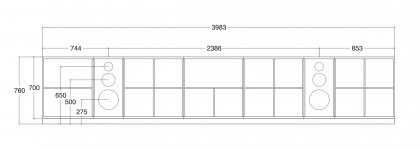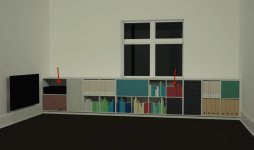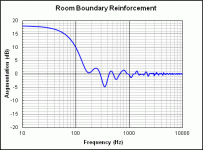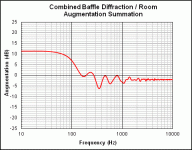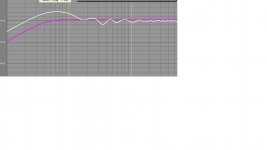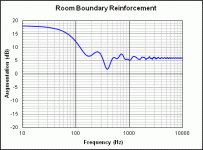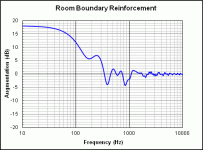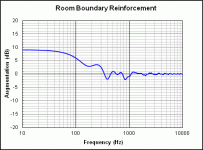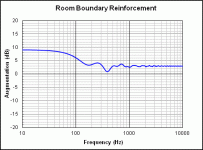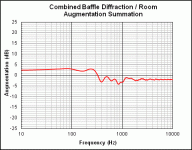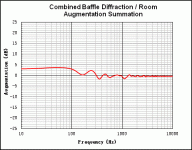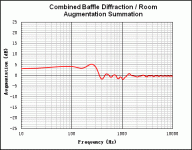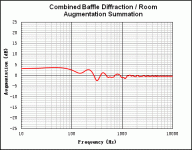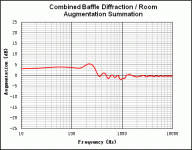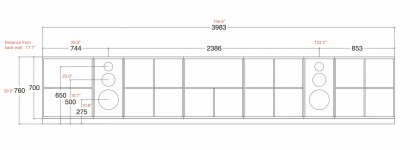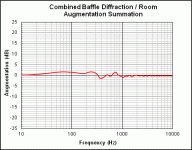Soren, this is one of the more interesting problems I seen asked at diyaudio. 
You want a not overly bassy speaker.
I think this SEAS unit fits the bill in reflex:
H1659-08 U22REX/P-SL
Now that has a very small requirement on filtering. Maybe 1mH and some sort of 4.7R and 6.8uF rolloff I seriously would give it a go with a simple cone tweeter and maybe 4.7uF 3.5kHz third order and 0.2mH coil treble filter with a bit of resistance attenuation thrown in:
HT-22/8
It's gonna sound great. Trust me.
No need for three way.
You want a not overly bassy speaker.
I think this SEAS unit fits the bill in reflex:
H1659-08 U22REX/P-SL
Now that has a very small requirement on filtering. Maybe 1mH and some sort of 4.7R and 6.8uF rolloff I seriously would give it a go with a simple cone tweeter and maybe 4.7uF 3.5kHz third order and 0.2mH coil treble filter with a bit of resistance attenuation thrown in:
HT-22/8
It's gonna sound great. Trust me.
No need for three way.
Last edited:
Thanks for input jReave. Some interesting food for thought 
I will definitely consider the EQ possibility, but first I will see how I can simulate a design without EQ, of course taking into account the room boundary reinforcement.
Interesting to see! I have attached a drawing of the bookshelf with the correct measurements in mm, not sure if that changes much. The total height of the bookshelf is 70cm (27.5”), the depth is 45cm (17.7”) and total width, which is also the width of the room, is 398cm (13’). I have also provided some approximate measurements to the centres of each driver.
I see what you mean. I have attached an updated rendering of the bookcase, the design has changed slightly since post #1. Regarding the cavities, we could possibly change the layout of the bookshelf a little, for example have doors in the shelves next to top left of the speakers (marked with arrows). I’m thinking it’s especially the tweeter and mid that will be affected by the cavity in the bookshelf, and perhaps these doors would help?
Good point. If I go with something like the aforementioned SS 15M/4624G00 midrange, which is 92.4dB, would it then make sense to go with a much less sensitive woofer, and maybe even make it sealed? This way I could get a smoother bass roll-off, which perhaps would suit the low frequent room boundary boost?
I think no matter what speaker you decide on, you are probably going to be best off using some form of eq for this kind of set-up to compensate for either the low end boundary reinforcements or the losses due to the bookshelf's cavity effects.
I will definitely consider the EQ possibility, but first I will see how I can simulate a design without EQ, of course taking into account the room boundary reinforcement.
First 2 charts are some rough estimates of the on-axis boundary effects of your set-up with the center of the driver about 9" off the floor, 32" to the side wall and 15" from the back wall. First chart shows the boundary effects and the 2nd is boundary plus baffle diffraction effects for a 10" woofer (baffle of about 13'W x 26"H x 15"D, ie. the whole bookcase).
Interesting to see! I have attached a drawing of the bookshelf with the correct measurements in mm, not sure if that changes much. The total height of the bookshelf is 70cm (27.5”), the depth is 45cm (17.7”) and total width, which is also the width of the room, is 398cm (13’). I have also provided some approximate measurements to the centres of each driver.
But your rendering in your 1st posts looks like the right speaker will be sitting beside something like a covered radiator so even if you fill all the rest of the shelves full and flush to the front edge, you are still going to get some cavity effects occurring with that speaker. See the next couple of charts.
I see what you mean. I have attached an updated rendering of the bookcase, the design has changed slightly since post #1. Regarding the cavities, we could possibly change the layout of the bookshelf a little, for example have doors in the shelves next to top left of the speakers (marked with arrows). I’m thinking it’s especially the tweeter and mid that will be affected by the cavity in the bookshelf, and perhaps these doors would help?
But also note that if designing your own and going without any eq, you need to be careful about your driver sensitivities. If you select an 88dB woofer that doesn't need baffle step compensation but actually gets some amount of dB boost below about 300Hz, then an 88dB mid is not going to be loud enough to match it.
Good point. If I go with something like the aforementioned SS 15M/4624G00 midrange, which is 92.4dB, would it then make sense to go with a much less sensitive woofer, and maybe even make it sealed? This way I could get a smoother bass roll-off, which perhaps would suit the low frequent room boundary boost?
Attachments
Soren, this is one of the more interesting problems I seen asked at diyaudio.
You want a not overly bassy speaker.
I think this SEAS unit fits the bill in reflex:
H1659-08 U22REX/P-SL
Now that has a very small requirement on filtering. Maybe 1mH and some sort of 4.7R and 6.8uF rolloff I seriously would give it a go with a simple cone tweeter and maybe 4.7uF 3.5kHz third order and 0.2mH coil treble filter with a bit of resistance attenuation thrown in:
HT-22/8
It's gonna sound great. Trust me.
No need for three way.
Thanks for the input, Steve. You seem to be the only one here recommending a 2-way design. I like your suggestion, especially from a cost perspective
One thing I wondered was the possibility of using a horn or waveguide for the tweeter. This idea was mentioned earlier in the thread (post #6), and also in another thread that discussed a similar topic, see post #5 in ‘Speakers for an actual bookshelf - seeking woofer recs.’
Besides the idea of “keeping those frequencies out of the bookshelf cavity” a horn or waveguide would also increase the sensitivity as well as making it possible to cross lower to e.g. a high-efficient woofer, which wouldn’t need the same bass extension due to room gain. Or am I overestimating the low frequency room gain caused by the speakers' position?
The total height of the bookshelf is 70cm (27.5”)
This was a mistake. The total height of the bookshelf is actually 76cm (30"). I forgot about the plinth, which is 6cm high and slightly recessed.
soren,
The graphs I posted are done using Jeff B's Diffraction and Boundary Simulator. It needs Excel and is very easy to use. You should download it and give it a try.
Below are the same graphs again but with your new dimensions. You can see that the bass reinforcement stays about the same but the main null has shifted upwards.
I think if you can fill up those book shelves and even add in some doors then you will be able to minimize any cavity effects, which if you look at the charts again (which were from Toole btw), show up mostly as big suck outs somewhere in the 200Hz - 600Hz range but that's going to depend on each particular case. The tweeter isn't actually affected much and for the woofer, it depends on the xo. The 1 thing you want to avoid in this case I think is having the floor and any cavity nulls happening at the same frequency. You would need a lot of boost in eq to fix that.
You would need a lot of boost in eq to fix that.
I was just also wondering if you could tailor a close box response to the boundary gain and diffraction patterns without any eq. The 3rd graph is a look at the 10" Scan Discovery sealed (pink) and then combined with the 2nd, red chart to give you the white result. You can see that the response is still far from optimal if you want to cross above 200Hz or so. Lower than that might work though which leads me to think of the possibility of a 2-way plus a sub or 2 for you. But that's just looking at 1 driver in 1 alignment so far. I'd look at at least a few more and the xo sims before giving up on the idea.
The graphs I posted are done using Jeff B's Diffraction and Boundary Simulator. It needs Excel and is very easy to use. You should download it and give it a try.
Below are the same graphs again but with your new dimensions. You can see that the bass reinforcement stays about the same but the main null has shifted upwards.
I think if you can fill up those book shelves and even add in some doors then you will be able to minimize any cavity effects, which if you look at the charts again (which were from Toole btw), show up mostly as big suck outs somewhere in the 200Hz - 600Hz range but that's going to depend on each particular case. The tweeter isn't actually affected much and for the woofer, it depends on the xo. The 1 thing you want to avoid in this case I think is having the floor and any cavity nulls happening at the same frequency.
I was just also wondering if you could tailor a close box response to the boundary gain and diffraction patterns without any eq. The 3rd graph is a look at the 10" Scan Discovery sealed (pink) and then combined with the 2nd, red chart to give you the white result. You can see that the response is still far from optimal if you want to cross above 200Hz or so. Lower than that might work though which leads me to think of the possibility of a 2-way plus a sub or 2 for you. But that's just looking at 1 driver in 1 alignment so far. I'd look at at least a few more and the xo sims before giving up on the idea.
Attachments
The first thing an experienced person would do when installing speakers in a room is size them. I have mentioned this before and so this will be the last time I promise. Are the speakers for quiet background music, standard listening levels or loud party music? Do you require bass or can you drop it to get loud or cheap? How important is it that peaks are not distorted? Earlier I had assumed "high fidelity" at standard listening levels but this may not be the case. Gathering this information will enable you to define the SPL requirements of the woofer for the seating position/s in your large room and consequently if an 8" is an option.Maybe I should stick with SS drivers but go with the 8” woofer and in a ported design. Good sensitivity and bass extension is okay. Then crossed to the SS mid. I will have to do some more sims, especially now looking at the room boundary reinforcement affects illustrated by jReave.
A waveguide would need to be much larger and deeper than you have space for to significantly reduce the frequencies in the low hundreds involved in your cavities. A small waveguide on a dome tweeter is primarily there to help with directivity particularly if crossing to a 5" or larger midrange (for example most good small pro 2 ways). The waveguide will boost the sensitivity at the low end of the tweeter range but not at the high end (for example). After correction in the crossover the effective sensitivity may even reduce. Compression drivers with large horns are different.
The boundary reinforcement plots does not contain all the physics. The room modes are missing, the cavity effects are missing, the rear wall is probably not fully accounted for, etc... Nonetheless it provides a guide to what is going on. It probably should be repeated with and without "doors" on the cavities to give some feel for full and empty bookcases. What does 0dB mean given that the high frequencies are 2dB down? The bass boost is occurring at frequencies below the normal crossover to a midrange. How best to handle this?
Yes, I agree with andy. You need to define your SPL and bass requirements before choosing drivers. And are these going to be for critical listening or will more for background music?
I've also realized that the boundary reinforcement graphs I've posted aren't completely correct for your situation. The side wall and floor gain will be correct but for the rear wall gain, you have a situation that can't be accurately simulated by this program - from the floor to 30" the full cabinet essentially becomes the rear wall (so the distance = 0") but above the cabinet the wall is 17.7" away. The graphs I posted assume 17.7" from the floor up. The 1st graph below shows the result if using 0" as the distance to the rear wall. Your situation is probably going to be somewhere in between these two. I could guestimate and say it's going to be equivalent to the sim'd results if we set the distance to the wall at about 6" (2nd graph) but I'm totally just guessing here.
On top of that, given your larger off-axis listening position, I'm also not sure that using the axial response (vs the power response) for the boundary effects is the right choice. The 3rd and 4th graphs show the same situation as the previous 2 graphs but this time as the power response which shows the effects to be weaker overall. Again, your actual reality may be somewhere in between these 2.
Also, andy I'm not sure why Jeff's program shows the baffle diffraction effects as being down about 2dB here. If I use the Edge, this isn't the case. So what I would probably do in my sims is make a 2dB adjustment in the positive direction.
So disregarding that 2dB difference for now, the last graph hows the boundary effects using the power response when calculated at 6" from the back wall combined with the baffle diffraction for a 10" driver 12" above the floor ignoring any possible cavity effects. And that doesn't actually look too bad.
So looking at the pattern of these graphs, I might choose a xo point of between 200Hz and 300Hz trying to use the natural roll-off in this area as the start of the xo function. Then I would try to have some extra dB's with the mid to play with and adjust its level by ear to match up with the woofer. This might work. It might not. It might depend on what level of SQ you are really looking for too.
But I think this is a situation where attempting to design just by simulations is going to be extra challenging. Here measurements are going to really help you out. Or again, a receiver that can do the same thing and make the necessary adjustments automatically to a sort of ballpark designed speaker.
Just my thoughts anyway.......
I've also realized that the boundary reinforcement graphs I've posted aren't completely correct for your situation. The side wall and floor gain will be correct but for the rear wall gain, you have a situation that can't be accurately simulated by this program - from the floor to 30" the full cabinet essentially becomes the rear wall (so the distance = 0") but above the cabinet the wall is 17.7" away. The graphs I posted assume 17.7" from the floor up. The 1st graph below shows the result if using 0" as the distance to the rear wall. Your situation is probably going to be somewhere in between these two. I could guestimate and say it's going to be equivalent to the sim'd results if we set the distance to the wall at about 6" (2nd graph) but I'm totally just guessing here.
On top of that, given your larger off-axis listening position, I'm also not sure that using the axial response (vs the power response) for the boundary effects is the right choice. The 3rd and 4th graphs show the same situation as the previous 2 graphs but this time as the power response which shows the effects to be weaker overall. Again, your actual reality may be somewhere in between these 2.
Also, andy I'm not sure why Jeff's program shows the baffle diffraction effects as being down about 2dB here. If I use the Edge, this isn't the case. So what I would probably do in my sims is make a 2dB adjustment in the positive direction.
So disregarding that 2dB difference for now, the last graph hows the boundary effects using the power response when calculated at 6" from the back wall combined with the baffle diffraction for a 10" driver 12" above the floor ignoring any possible cavity effects. And that doesn't actually look too bad.
So looking at the pattern of these graphs, I might choose a xo point of between 200Hz and 300Hz trying to use the natural roll-off in this area as the start of the xo function. Then I would try to have some extra dB's with the mid to play with and adjust its level by ear to match up with the woofer. This might work. It might not. It might depend on what level of SQ you are really looking for too.
But I think this is a situation where attempting to design just by simulations is going to be extra challenging. Here measurements are going to really help you out. Or again, a receiver that can do the same thing and make the necessary adjustments automatically to a sort of ballpark designed speaker.
Just my thoughts anyway.......
Attachments
Thanks for all the input and help! It’s really appreciated 
Okay, I will try to give some more info. My friend is most of the time not going to use the speakers for critical listening. His current setup consists of a Cambridge Audio Azur 340se stereo amp (2 x 45W into 8ohm) driving 4 x Tannoy Mercury F1 Custom bookshelf speakers (speaker A+B) placed more or less randomly around the room (one one the fridge in the kitchen, another on the corner of the floor in the living room, etc... you get the picture). My friend is not looking for flat FR, critical listening hi-end speakers, but rather good-value fun sounding speakers that have bass enough to pressurise the 43 m2 room and go party-loud occasionally without distorting. I would say most of the time these speaker will be for background listening (their stereo is always playing ). My friend loves music and will hopefully enjoy what I will end up building. That being said I have only built proven designs so far, lastly Jeff B’s Piccolos, which I currently use in my own 20 m2 living room and really enjoy. And so does my friend, which is why I’m now here on this forum asking you guys for advice
). My friend loves music and will hopefully enjoy what I will end up building. That being said I have only built proven designs so far, lastly Jeff B’s Piccolos, which I currently use in my own 20 m2 living room and really enjoy. And so does my friend, which is why I’m now here on this forum asking you guys for advice 
BTW, he is aware that the new speakers probably will benefit from a higher powered stereo amp and I am also looking into this, but I won’t give him advice on what to buy until I have figured out what speakers it will need to drive.
The first thing an experienced person would do when installing speakers in a room is size them. I have mentioned this before and so this will be the last time I promise. Are the speakers for quiet background music, standard listening levels or loud party music? Do you require bass or can you drop it to get loud or cheap? How important is it that peaks are not distorted? Earlier I had assumed "high fidelity" at standard listening levels but this may not be the case. Gathering this information will enable you to define the SPL requirements of the woofer for the seating position/s in your large room and consequently if an 8" is an option.
Yes, I agree with andy. You need to define your SPL and bass requirements before choosing drivers. And are these going to be for critical listening or will more for background music?
Okay, I will try to give some more info. My friend is most of the time not going to use the speakers for critical listening. His current setup consists of a Cambridge Audio Azur 340se stereo amp (2 x 45W into 8ohm) driving 4 x Tannoy Mercury F1 Custom bookshelf speakers (speaker A+B) placed more or less randomly around the room (one one the fridge in the kitchen, another on the corner of the floor in the living room, etc... you get the picture). My friend is not looking for flat FR, critical listening hi-end speakers, but rather good-value fun sounding speakers that have bass enough to pressurise the 43 m2 room and go party-loud occasionally without distorting. I would say most of the time these speaker will be for background listening (their stereo is always playing
BTW, he is aware that the new speakers probably will benefit from a higher powered stereo amp and I am also looking into this, but I won’t give him advice on what to buy until I have figured out what speakers it will need to drive.
Hi,
Well there are plenty of cooks - you know the problem.
The amplifier will be fine - and it will probably put out
about 80W into 4 ohm speakers, which is plenty.
It also has tone controls which could be useful.
(Yes you can get better, but only IMO to drive
some real loudspeakers in the room like these :
https://sites.google.com/site/undefinition/tarkus
[one of my favourite designs, a budget WATT/Puppy.]
but the above will still be great with the Cambridge,
and in real respects trash any inbuilt speakers with
any amplifier that is a reasonable upgrade from it.)
Beware of simulation models that give you pretty
graphs (or ugly ones) without knowing what the
model is exactly doing, (like an unspecified axis).
Tools don't give you skills, using them properly does.
TBH, I have some sympathy with S7's attitude,
basically sometimes, come on, it can't be that
complicated, and you're overegging the pudding.
TBH I stiill like the ZD3C. You could twist the
bass drivers across the baffle to get them
as near to to the mid as possible.
(e.g. left speaker top bass unit to the right
as much as possible, bottom bass unit up
and to the left as much as possible, port in
the bottom left hand corner between drivers.)
YMMV, but you need a recipe.
rgds, sreten.
TBH studying Zaph's info I can't really
work out why my suggestion is wrong.
Graphs that show it is may be wrong.
Well there are plenty of cooks - you know the problem.
The amplifier will be fine - and it will probably put out
about 80W into 4 ohm speakers, which is plenty.
It also has tone controls which could be useful.
(Yes you can get better, but only IMO to drive
some real loudspeakers in the room like these :
https://sites.google.com/site/undefinition/tarkus
[one of my favourite designs, a budget WATT/Puppy.]
but the above will still be great with the Cambridge,
and in real respects trash any inbuilt speakers with
any amplifier that is a reasonable upgrade from it.)
Beware of simulation models that give you pretty
graphs (or ugly ones) without knowing what the
model is exactly doing, (like an unspecified axis).
Tools don't give you skills, using them properly does.
TBH, I have some sympathy with S7's attitude,
basically sometimes, come on, it can't be that
complicated, and you're overegging the pudding.
TBH I stiill like the ZD3C. You could twist the
bass drivers across the baffle to get them
as near to to the mid as possible.
(e.g. left speaker top bass unit to the right
as much as possible, bottom bass unit up
and to the left as much as possible, port in
the bottom left hand corner between drivers.)
YMMV, but you need a recipe.
rgds, sreten.
TBH studying Zaph's info I can't really
work out why my suggestion is wrong.
Graphs that show it is may be wrong.
Last edited:
A waveguide would need to be much larger and deeper than you have space for to significantly reduce the frequencies in the low hundreds involved in your cavities. A small waveguide on a dome tweeter is primarily there to help with directivity particularly if crossing to a 5" or larger midrange (for example most good small pro 2 ways). The waveguide will boost the sensitivity at the low end of the tweeter range but not at the high end (for example). After correction in the crossover the effective sensitivity may even reduce. Compression drivers with large horns are different.
Alright, and I assume a 2-way speaker with a high sensitive woofer + compression driver horn wouldn’t be good for this setup? I guess such speaker would mean sacrificing the low-end extension compared to e.g. a 10” 3-way “hi-fi” speaker?
I've also realized that the boundary reinforcement graphs I've posted aren't completely correct for your situation. The side wall and floor gain will be correct but for the rear wall gain, you have a situation that can't be accurately simulated by this program - from the floor to 30" the full cabinet essentially becomes the rear wall (so the distance = 0") but above the cabinet the wall is 17.7" away. The graphs I posted assume 17.7" from the floor up. The 1st graph below shows the result if using 0" as the distance to the rear wall. Your situation is probably going to be somewhere in between these two. I could guestimate and say it's going to be equivalent to the sim'd results if we set the distance to the wall at about 6" (2nd graph) but I'm totally just guessing here.
On top of that, given your larger off-axis listening position, I'm also not sure that using the axial response (vs the power response) for the boundary effects is the right choice. The 3rd and 4th graphs show the same situation as the previous 2 graphs but this time as the power response which shows the effects to be weaker overall. Again, your actual reality may be somewhere in between these 2.
Also, andy I'm not sure why Jeff's program shows the baffle diffraction effects as being down about 2dB here. If I use the Edge, this isn't the case. So what I would probably do in my sims is make a 2dB adjustment in the positive direction.
Alright, thanks for the explanation. Not sure I fully understand why you say the situation can’t be simulated. I tried to do some sims on my own. I put in the baffle width to 156.8” and the height to 29.9”, speaker location for left 10” woofer to X=29.3” Y=10.80 (right woofer is X=123.2”, Y=29.3”). Under Room Boundary Reinforcement I put distance from side wall and height above floor to be the same as speaker’s location XY. This I assume is the same as saying the baffle side and bottom is the same as the side wall and floor, i.e. infinite baffle. As distance from rear wall I have put 17.7” (45cm), but also tried with 6” as you did, which give me sort of similar results as you, at least for the L woofer. First graph is L woofer with 17.7” to rear wall, then with 6” distance, then the R woofer with 17.7” and 6” distance (all with power rather than axial response). I’ve also attached a drawing with the mm->inches measurements I’ve used.
But again, why do you say 17.7” to back wall is incorrect? And how do you guesstimate 6” to be closer to reality?
So disregarding that 2dB difference for now, the last graph hows the boundary effects using the power response when calculated at 6" from the back wall combined with the baffle diffraction for a 10" driver 12" above the floor ignoring any possible cavity effects. And that doesn't actually look too bad.
So looking at the pattern of these graphs, I might choose a xo point of between 200Hz and 300Hz trying to use the natural roll-off in this area as the start of the xo function. Then I would try to have some extra dB's with the mid to play with and adjust its level by ear to match up with the woofer. This might work. It might not. It might depend on what level of SQ you are really looking for too.
Interesting thought. Maybe I will try and sim something like a sealed 10” woofer crossed at 200-300Hz to a midrange with a few dB higher sensitivity.
But I think this is a situation where attempting to design just by simulations is going to be extra challenging. Here measurements are going to really help you out. Or again, a receiver that can do the same thing and make the necessary adjustments automatically to a sort of ballpark designed speaker.
I see your point. EQ has crossed my mind. I actually have measurement gear and a miniDSP 2x4 lying around somewhere, which I could potentially use once we get to actually testing the speakers in the setup.
BTW, the redesign of the living room and rest of the flat will begin in two weeks time and should be done by the end of the month. By that time I hope I’m closer to having the speakers built
Attachments
Last edited:
Having specified that you sometimes require party loud in a large room and are more interested in "fun" rather than "high fidelity" then this would seem to be an option. You will not get deep bass but using a port and working with the bass reinforcement you might get to 50-60Hz or so. It depends on how you juggle things. 10" is a bit small for this type of speaker. You will find more existing designs at 12" and 15" (for example).Alright, and I assume a 2-way speaker with a high sensitive woofer + compression driver horn wouldn’t be good for this setup? I guess such speaker would mean sacrificing the low-end extension compared to e.g. a 10” 3-way “hi-fi” speaker?
A 3 way can give better bass and, if competently designed, more "high fidelity" but it will be at the cost of not being able to play as loud cleanly.
Alright, thanks for the explanation. Not sure I fully understand why you say the situation can’t be simulated........ why do you say 17.7” to back wall is incorrect? And how do you guesstimate 6” to be closer to reality?
Ok, let's see if I can explain this. Boundary gain is based on the degree to which boundaries diminish the large 360* spherical space that a speaker plays into. Put a speaker on a tall pole out in your backyard and it will be playing into true 4pi space. Put it on the ground and now you've just sliced a piece off the bottom of the sphere. Put it close to a back and/or side wall and you've just sliced off more pieces of that larger sphere. Each time the space the speaker has to play into gets smaller and smaller, the frequencies that relate to the distances of those slicing boundaries will play louder. See this - True Audio Speaker Topics: Spatial Loading - if that's confusing.
Now look at the sophistication of the boundary reinforcement section of the diffraction program. How can it tell the difference between your speakers in the shelving unit (shelves fully loaded) and the same speakers in the same positions but with the shelving unit completely absent? If you use the same 17.7" distance to the back wall in both cases (distances to the floor and to the side walls will and should remain exactly the same) then you are going to get the exact same simulation which can't be right. The 2 sets of speakers are definitely playing into 2 very different acoustical spaces.
So now if you set the distance to the back wall as 0" then essentially the full shelving unit has become the back wall. But clearly this isn't correct either because the shelf only goes up to 30" (ie. is acting as an infinite baffle only up to that height) and then the actual back wall begins 17.7" to the rear. So in other words, the correct spacial loading would be correctly represented if you could set the distance to the rear wall as 0" from the floor up to 30" and then set it to 17.7" from 30" upward. Which of course the program cannot do.
But the correct actual spacial loading will be somewhere between those 2 rear wall settings, between 0" and 17.7". So I was just guessing that the nearer spacial loading (ie. the wall to wall shelving) would have the greater influence, and therefore plugged in a value closer to 0 than to 17.7. Maybe that's incorrect. Maybe 12" would be closer to reality. Or 9". It was meant as ballpark only.
But now that I know that you're not after a super critical listening set-up, I wouldn't worry too much about getting the absolutely flattest response possible. That frequency response is going to vary anyways depending on where a person is standing or sitting anywhere in the listening environment.
So if you want to design your own, do the sims and see how it sounds. If you like it, then you're all set. If it sounds a little off, then EQ it. For that matter, like I said before, going with an established design and EQ'ing it won't be that much different. Or since it sounds like you are able to measure, do so for the in-box in-shelf response and then design the xo - you shouldn't need to EQ after that.
Thanks jReave for the detailed explanation. I understand better now.
I have been looking at other potential drivers for a 3-way design. Monacor’s “Number One” series have some interesting options. Here is an idea for a 55L ported 3-way:
Bass: 10” Monacor SPH-250TC (2 x 8ohm, 91dB)
Midrange: 5.5” Monacor MS-130 (8ohm, 94dB)
Tweeter: 1” Monacor DT-109 (8ohm, 90dB)
I’m thinking about crossing around 200Hz and 2800Hz. The bass driver is known from a German DIY subwoofer design, but the driver should have no problem in crossing higher than the usual subwoofer low-pass. The midrange I can’t find much info about, but I like the high-sensitivity.
What do you think?
I have been looking at other potential drivers for a 3-way design. Monacor’s “Number One” series have some interesting options. Here is an idea for a 55L ported 3-way:
Bass: 10” Monacor SPH-250TC (2 x 8ohm, 91dB)
Midrange: 5.5” Monacor MS-130 (8ohm, 94dB)
Tweeter: 1” Monacor DT-109 (8ohm, 90dB)
I’m thinking about crossing around 200Hz and 2800Hz. The bass driver is known from a German DIY subwoofer design, but the driver should have no problem in crossing higher than the usual subwoofer low-pass. The midrange I can’t find much info about, but I like the high-sensitivity.
What do you think?
Dissipating lots of power in a crossover in order that the midrange and woofer will match an insensitive tweeter does not seem sensible.What do you think?
Why have you now chosen 3 drivers from Monacor? What was wrong with using the appropriate combination of drivers from the standard SS and SB ranges you were talking about earlier?
No experience with Monacors but I have heard some decent things about some of their yellow kevlar drivers. These aren't those ones however.
That's a dual voice coil woofer - I'm not sure that's what you want to use.
Fs on the mid is spec'd at 120Hz but the graph shows the resonant frequency peak at 200Hz. That makes me wary of the manufacturer's data. In either case, neither is really suitable for a 200Hz xo.
And yes, the tweeter sensitivity is too low to match the woofer (which is the driver that is going to set the speaker's output level).
That's a dual voice coil woofer - I'm not sure that's what you want to use.
Fs on the mid is spec'd at 120Hz but the graph shows the resonant frequency peak at 200Hz. That makes me wary of the manufacturer's data. In either case, neither is really suitable for a 200Hz xo.
And yes, the tweeter sensitivity is too low to match the woofer (which is the driver that is going to set the speaker's output level).
Dissipating lots of power in a crossover in order that the midrange and woofer will match an insensitive tweeter does not seem sensible.
Why have you now chosen 3 drivers from Monacor? What was wrong with using the appropriate combination of drivers from the standard SS and SB ranges you were talking about earlier?
I was looking for a 10” that would go deep and work in a ~50L enclosure and preferably something a little cheaper than the SB. This was harder to find than I thought it would be, but the Monacor seemed to fit the bill. Also, the German magazine that made the subwoofer design is a reputable and well-known source for proven designs.
And while looking at Monacor’s drivers I wondered if they had mids and tweeters that would work for the project. I see what you mean about the tweeter having too low sensitivity, maybe something like the Monacor DT-254 (92dB) would be better for the application?
But again, it’s not that I’m set on Monacor now. I could also mix the brands and go with e.g. the Monacor woofer and the SS mid and tweeter.
Last edited:
That's a dual voice coil woofer - I'm not sure that's what you want to use.
Why not?
Fs on the mid is spec'd at 120Hz but the graph shows the resonant frequency peak at 200Hz. That makes me wary of the manufacturer's data. In either case, neither is really suitable for a 200Hz xo.
I see.
soren5, your project kind of interested me so I was looking at some drivers and how they simmed. The conclusion I reached is that again, this is kind of a tricky situation to sim accurately and you may be best off using some eq in the end to get it right if you can't measure.
I figured out a few things regarding diffraction and boundary gain for your situation. First, for the purposes of simulations, I may have previously over-estimated the boundary reinforcement effects. This is because in the case of simming a typical speaker, we don't normally include the boundary effects. Which is to say that we are generally modelling a speaker to be flat in an anechoic environment. However in your case, because the baffle is so wide and goes from wall to wall, I think we should include the side wall effects and since the woofer is so close to the floor, we should probably also include the floor effects. On the other hand, your cabinet still sits out from the back wall the same as any other speaker does, so my gut feeling is that this one shouldn't be included in the simulation. (In the diffraction program, set the distance to something very large like 9999" to nullify its effects.) The effect is 3dB less boost to the low frequencies.
Secondly, the diffraction simulation itself is not quite accurate either. This is because the program bases its calculations on the distances from the driver to all the edges around a speaker's perimeter. In your case however, there are no edges on the sides of your front baffle (ie. the whole front of the shelving unit which meets the walls at the sides) but the program doesn't know that and still proceeds as if there were. We correct for the baffle step loss in this process by including the side wall boundary effects but the ripples above that are still not going to be quite right.
And lastly given your off-axis listening positioning, I would also adjust the mic distance and the vertical and horizontal off-axis listening angles in the diffraction section to something like 40" high, centered and about 10ft away.
Given all of that, the graph below shows the combined diffraction and boundary effects for a 10" woofer. Slightly different than what I posted previously. Ht off the floor=12", mic d=10', vertical axis=13.1* (27.9" above the driver), horizontal axis=21* (46.1" to right or left of the driver) and d to rear wall=9999". Although it's still not going to be perfectly accurate, this is what I think will get you the best in terms of simulations and is what I would be using if I was doing it. It may work out fine or it may require some playing around with resistors on the mid/tweeter or some kind of EQ'ing.
I mention it because it makes a difference in terms of selecting drivers and matching their sensitivities.
I figured out a few things regarding diffraction and boundary gain for your situation. First, for the purposes of simulations, I may have previously over-estimated the boundary reinforcement effects. This is because in the case of simming a typical speaker, we don't normally include the boundary effects. Which is to say that we are generally modelling a speaker to be flat in an anechoic environment. However in your case, because the baffle is so wide and goes from wall to wall, I think we should include the side wall effects and since the woofer is so close to the floor, we should probably also include the floor effects. On the other hand, your cabinet still sits out from the back wall the same as any other speaker does, so my gut feeling is that this one shouldn't be included in the simulation. (In the diffraction program, set the distance to something very large like 9999" to nullify its effects.) The effect is 3dB less boost to the low frequencies.
Secondly, the diffraction simulation itself is not quite accurate either. This is because the program bases its calculations on the distances from the driver to all the edges around a speaker's perimeter. In your case however, there are no edges on the sides of your front baffle (ie. the whole front of the shelving unit which meets the walls at the sides) but the program doesn't know that and still proceeds as if there were. We correct for the baffle step loss in this process by including the side wall boundary effects but the ripples above that are still not going to be quite right.
And lastly given your off-axis listening positioning, I would also adjust the mic distance and the vertical and horizontal off-axis listening angles in the diffraction section to something like 40" high, centered and about 10ft away.
Given all of that, the graph below shows the combined diffraction and boundary effects for a 10" woofer. Slightly different than what I posted previously. Ht off the floor=12", mic d=10', vertical axis=13.1* (27.9" above the driver), horizontal axis=21* (46.1" to right or left of the driver) and d to rear wall=9999". Although it's still not going to be perfectly accurate, this is what I think will get you the best in terms of simulations and is what I would be using if I was doing it. It may work out fine or it may require some playing around with resistors on the mid/tweeter or some kind of EQ'ing.
I mention it because it makes a difference in terms of selecting drivers and matching their sensitivities.
Attachments
I was looking for a 10” that would go deep and work in a ~50L enclosure and preferably something a little cheaper than the SB. This was harder to find than I thought it would be...
Yes also I ran into problems looking for 10"ers. As well as price, F3 and box size, as well as being an 8ohm driver, the biggest reason for that was when I went to look at the impedance and more specifically the impedance phase angle, a number of them start presenting very low phase angles to the amplifiers in the usable frequency range. Technically I believe this means that the load gets quite capacitive which requires a pretty high current amplifier or the typical solution, a separate sub amplifier.
Looking at how the phase sims, the Monacor is about the same as the SB 29NRX, both of whom's phase angle gets down to about -60* which is about as low as you want to go as long as the impedance isn't too low at that frequency as well.
With 2 voice coils if you want to run them separately then I think you'll need 2 amps although I guess you can just run it with 1 voice coil but I'm not 100% sure of that. Wire the 2 voice coils in parallel and the impedance drops to 3.4ohm and that's before any effects of the xo which I think will be too low for your application.
Also if driver specs are to be trusted, although it has a low Fs (26Hz), F3 doesn't come out close to that in a vented alignment. It actually wants a smaller box than 50L. I get F3=52Hz in 20L.
I actually thought that the budget you mentioned would be quite comfortable with drivers in the SB price range. I would stick with SB woofer and tweeter and maybe a 4ohm SB mid (either 5" or 6") if you think 4ohm minima or thereabouts will be ok with the amp or a different higher sensitivity 8ohm mid if it won't, possibly an Audax HM130Z (although I guess that's a bit pricy as well).
- Status
- This old topic is closed. If you want to reopen this topic, contact a moderator using the "Report Post" button.
- Home
- Loudspeakers
- Multi-Way
- 3-way for bookshelf (in-wall)
